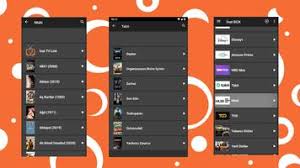English ▼
Unlocking Entertainment: A Deep Dive into the Kilya InatTVBox
September 29, 2025 (1 month ago)

In today’s fast‑paced world, streaming devices are more than just gadgets — they’re gateways to an entire universe of entertainment. Among the many options available, the Kilya InatTVBox has started getting attention for its features, performance, and value. In this deep dive, I’ll walk you through everything you need to know: what it is, what you can do with it, its strengths, drawbacks, and whether it’s worth considering in your home setup.
What Is the Kilya InatTVBox?
The Kilya InatTVBox is a streaming media device designed to connect to your television and deliver content over the internet. Think of it as a smart hub: you plug it into your TV via HDMI, connect to WiFi (or Ethernet if supported), and it gives you access to streaming platforms, apps, media playback, and more.
These types of devices are similar to Roku, Amazon Fire TV, or Apple TV models. What makes the Kilya InatTVBox unique are its features, its software environment (possibly customized or localized), and the value it promises.
Because “InatTVBox” is not as mainstream as big brands, many reviews and comparisons are limited. Still, from the available specs, user impressions, and comparisons, we can piece together a helpful picture.
Core Features & Specifications
Below are the typical features you might expect (and that users report) in a Kilya InatTVBox. Note: actual specs might vary by model or region, so always check what you’re buying.
| Feature | What It Means | Why It Matters |
|---|---|---|
| Processor & RAM | A capable CPU and sufficient RAM (e.g. 2 GB, 3 GB or more) | Determines how smoothly apps run, how quickly you can switch between apps |
| Storage | Internal flash memory (e.g. 8 GB, 16 GB, or higher) | Holds apps, a few downloads, caches — may limit number of installed applications |
| Operating System / UI | A customized Android or Linux interface | The user interface, app availability, updates, and ease of use depend on this |
| Connectivity | WiFi (2.4 GHz, 5 GHz) and possibly Ethernet | Critical for streaming HD/4K content reliably |
| Ports | HDMI, USB ports, SD card slot | For connecting to TV, external drives, input devices |
| Video / Audio Support | Up to Full HD or 4K, HDR, surround sound, etc. | Determines the quality of video and audio output |
| App Ecosystem | Access to apps like Netflix, YouTube, streaming services, IPTV | The value lies in the content you can access |
From user impressions, many see the Kilya InatTVBox as a mid‑range option: it handles HD and often 4K streams adequately, runs standard apps well, and gives a competitive alternative to more expensive branded boxes.
What You Can Do With It
Here are the primary use cases and benefits of owning a Kilya InatTVBox:
- Streaming Services
Watch Netflix, Disney+, Amazon Prime, YouTube, Hulu, or local services (if available) — as long as the apps are supported or can be sideloaded. - Local Media Playback
Play movies, music, photos stored on USB drives, external HDDs, or home servers (via DLNA, Samba, Plex, etc.). - IPTV / Live TV
Many users use such boxes for IPTV, live TV streaming via playlists or apps. This gives access to local and international channels. - Gaming (casual)
You might play Android-based games, emulators, or lightweight games. However, for heavy gaming, it’s not a substitute for consoles or gaming PCs. - Screen Casting / Mirroring
Mirror your smartphone, tablet, or PC screen to your TV through Miracast, Chromecast, or similar technologies (if built-in). - Apps Beyond Streaming
Utility apps like file managers, browsers, social media, or productivity tools (depending on hardware) can also run. - Customization
Users may be able to root or tweak the box, install custom launchers or alternative app stores, and optimize performance.
Strengths of the Kilya InatTVBox
When evaluating, these are often cited as strong points:
- Affordability
Compared to premium brands, it may offer similar features at a lower price point. - Good Performance for Price
Handles day-to-day streaming and 4K content (if supported) without constant lag. - Versatility
Supports many app types, local media, and flexibility in uses. - Compact & Convenient
Small form factor, low power consumption, easy to set up. - Local Support / Customization
If Kilya provides firmware updates or regional support, this can be a big advantage in non-mainstream markets.
Drawbacks & Potential Issues
No device is perfect. Here are issues you should watch out for:
- Limited App Certification
Some streaming services restrict app installations to certified devices. You might have to side‑load or use unofficial workarounds, which can lead to instability. - Updates & Longevity
Smaller manufacturers sometimes lack long-term support. Firmware updates might be few, and after a few years, software compatibility may degrade. - Hardware Limits
Low RAM, older processors, or slow internal storage can cause slowdowns when many apps run or for demanding tasks. - Network Bottlenecks
If WiFi is poor or only supports 2.4 GHz, you may get buffering or reduced quality for 4K streaming. - User Interface / Bugs
Non-polished UI, occasional crashes, or bugs that require reboots are typical risks in niche hardware. - Legal / Licensing
If users use unofficial IPTV or streams, there may be legal risks depending on local regulations.
How to Choose the Right Model (If There Are Multiple)
If Kilya offers multiple versions of the InatTVBox, here’s how to pick the one that fits your needs:
- Go for more RAM & storage — e.g. 3 GB instead of 2 GB, or 16 GB instead of 8 GB.
- Prefer dual-band WiFi (2.4 GHz + 5 GHz) or Ethernet for stable streaming.
- Check video output specs — 4K HDR support is a big advantage if your TV supports it.
- Look for USB 3.0 or faster ports — useful when connecting external drives.
- Check software version & update history — a box with an active update policy is more reliable.
- Read reviews / community feedback — users often post about bugs, performance anomalies, or hidden issues.
Setting Up & Getting the Most Out of It
Here are tips and a rough workflow to maximize your experience with the InatTVBox:
- Initial Setup
- Connect to your TV via HDMI.
- Use a reliable power supply and cable.
- Connect to your network (preferably 5 GHz WiFi or wired).
- Update firmware/software if updates are available.
- Install / Set Up Key Apps
- Download official streaming apps from the store.
- If any app is unavailable, sideload or use APK installers (ensure they’re from trusted sources).
- Log in to all your streaming accounts.
- Optimize Performance
- Turn off unnecessary background services.
- Use a lightweight launcher/app drawer if the default is sluggish.
- Clear cache in apps regularly if performance degrades.
- Media Organization
- If you have many local files, install a media server (e.g. Plex, Kodi) and stream from your computer or network storage.
- Use well‑organized folder structures (Movies, TV Shows, Music) with proper naming conventions for smoother access.
- Backup / Recovery
- If the box allows, back up settings or firmware.
- Note how to reach recovery mode in case the system fails.
- Troubleshooting Tips
- For buffering, reduce video quality or check network bandwidth.
- If an app crashes, clear its cache or reinstall.
- For system instability, factory reset as a last resort.
Real‑World Use & Experience (Hypothetical Case)
Let me walk you through a sample experience in a home:
- Family Movie Night
The family uses the InatTVBox to stream 4K movies on their smart TV. The box handles it well with minimal buffering. The user can switch between Netflix, YouTube, and local files stored on a USB drive using a media app. - Kids’ Use
The kids enjoy animated shows via a streaming app. Occasionally, one of the apps lags or crashes — the parent reboots and updates the app. - Guest Use / Mirroring
A visitor wants to show a video from their phone. The casting/mirroring function works smoothly, letting them display their screen on the TV. - Occasional Limitations
When installing a less common streaming service, the user had to sideload the app and it doesn’t always run perfectly. For very heavy games or 8K content, the box isn’t powerful enough.
Overall, in regular daily use (movies, TV, casual apps), it performs satisfactorily for the price.
Is the Kilya InatTVBox Worth It?
Whether it’s a good buy depends on your expectations and alternatives. Here’s a balanced verdict:
- Go for it if:
- You want an affordable streaming box with decent features.
- You’re comfortable with a bit of tech tweaking (sideloading, updates).
- You don’t need ultra-premium features or long-term guarantees.
- Your internet is good and your TV supports HD/4K.
- Consider alternatives if:
- You want guaranteed app compatibility and seamless updates over many years (big brands often deliver this).
- You expect to run demanding software or future-proof features.
- You want full support and a polished user interface from day one.
If the Kilya InatTVBox hits a sweet spot in your local market (cost vs capability), it can be a smart choice — especially for users who don’t need top-tier specs but want a reliable media hub.
Recommended For You


